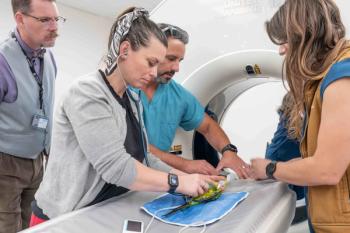
Abnormal reproductive ultrasononography in bitches and queens (Proceedings)
In the bitch and queen, documented abnormalities of the estrous cycle, pregnancy and the periparturient period, and even disorders of the residual reproductive tract in ovariohysterectomized females, call for ultrasonographic evaluation of the uterus and ovaries.
Disorders of the Reproductive Tract
In the bitch and queen, documented abnormalities of the estrous cycle, pregnancy and the periparturient period, and even disorders of the residual reproductive tract in ovariohysterectomized females, call for ultrasonographic evaluation of the uterus and ovaries. Serial examinations may be necessary during various parts of the estrous cycle to evaluate differences in ovarian and uterine appearance with normal hormonal fluctuations (i.e. ovarian 'cyst' vs. normal corpora lutea) and parturition (i.e. post partum metritis vs. subinvolution).
Discussion of some of the controversial and challenging clinical problems familiar to the small animal reproductive practice follows. In each of these cases ultrasound was essential to the diagnosis; our discussion will begin with an overview on technique.
Cystic Endometrial Hyperplasia/Pyometra, Post Partum Metritis
Ultrasonographic evaluation of the uterus provides important information concerning uterine wall thickness and composition (presence of cystic structures), lumen size and content, and overall organ symmetry and position. Cystic endometrial hyperplasia is characterized by endometrial thickening with focal anechoic structures noted in the uterine wall representing dilated cystic glands and tortuous glandular ducts. With advanced disease, these changes do not disappear ultrasonographically during anestrus. Fluid accumulation in the uterine lumen may represent hydrometra, mucometra or developing pyometra, and can be very difficult to differentiate (echogenicity may suggest cellularity). Because of the potential for peritonitis, centesis is not generally advocated. Cytology (± culture) of vaginal secretions is preferred. Because pyometra is associated with diestrus, measurement of a serum progesterone level can support the diagnosis and help differentiate if from hydrometra and mucometra, both of which can proceed to pyometra. Additional hematologic and biochemical abnormalities associated with pyometra (leukocytosis, azotemia, polydipsia/polyuria) should be sought.
Uterine enlargement with pyometra is variable. Evaluation of the uterine lumen post partum for retained placentae, mummified fetuses or masses is best accomplished with ultrasound. Post partum metritis is best differentiated form the normal post partum uterine enlargement by a failure of normal progressive decrease in uterine lumen contents and horn width. The bitch involutes and repairs for 16 weeks, making the normal post partum uterus prominent. The diagnosis and medical management of the cystic endometrial hyperplasia/pyometra complex or post partum metritis (usually with prostaglandins, progesterone inhibitors and antiprolactins) is best monitored by serial evaluations of uterine luminal contents with ultrasound along with hematology, biochemistry and clinical parameters (appetite, fever, vaginal discharge). The therapeutic use of prostaglandins should always be preceded by an ultrasound evaluation for pregnancy, due to their action as effective abortifacients.
Pregnancy Termination
Purposeful induction of abortion with drugs (prostaglandins, dexamethasone, antiprogestins) also requires serial ultrasonographic evaluations to determine the endpoint of therapy, as most protocols will result in delivery of viable neonates if terminated prematurely. Loss of fetal viability usually precedes expulsion of fetuses by 12-48 hours.
Infertility
Differentiation of infertility due to a failure to conceive vs resorption or abortion can only be accomplished with serial ultrasonographic examinations of the uterus after breeding. Early resorption of fetuses can be documented by serial ultrasound evaluations of the gravid uterus.
The ovaries can be imaged to evaluate their presence, size and echogenicity. Fluid filled, pathologic follicular, luteal or nonfunctional cysts within ovaries can be readily imaged and persist over time, supporting the diagnosis of cystic ovarian disorders causing abnormalities in the estrous cycle (prolonged estrus, prolonged interestrus intervals). Pathologic ovarian cysts can be unilateral or bilateral, single or multiple, but must be differentiated from normal cystic structures during appropriate parts of the estrous cycle (follicles, CLs).
Post Ovariohysterectomy Disorders/Abnormal Vaginal Discharge
Ultrasound permits evaluation of the cervix, complementing vaginoscopic evaluations in which the caudal os can be the only part visualized. Uterine stump pyometra (if functional ovarian tissue is present), stump granuloma (secondary to local disease) or hematoma (coagulopathy or surgical error) can be visualized just cranial to the pubis, between the bladder and colon as a complex mass lesion. Vaginal foreign bodies (grass awns) can be imaged ultrasonographically in the cranial vagina and cervical area.
Neoplasia
Finally, uterine neoplasia is typically of altered echogenicity to the surrounding uterine tissue, having complex internal architecture and may project into the uterine lumen. Alterations in ovarian dimensions or echogenicity can occur with neoplastic disorders, necessitating laparotomy and biopsy. Tumors of the ovaries can also be unilateral or bilateral and can be functional causing estrous cycle abnormalities. Histopathology is usually required to differentiate pathologic ovarian cysts from neoplasia, both can occur simultaneously.
Newsletter
From exam room tips to practice management insights, get trusted veterinary news delivered straight to your inbox—subscribe to dvm360.






